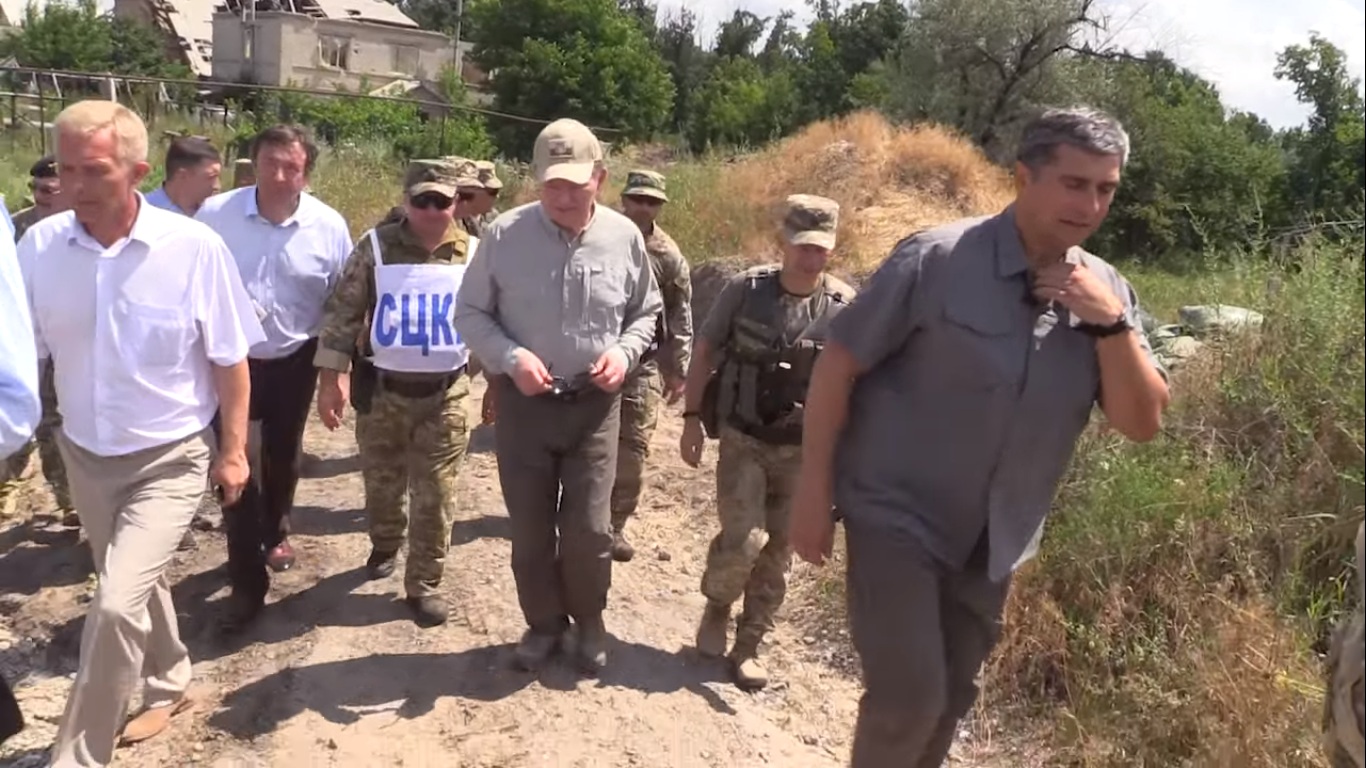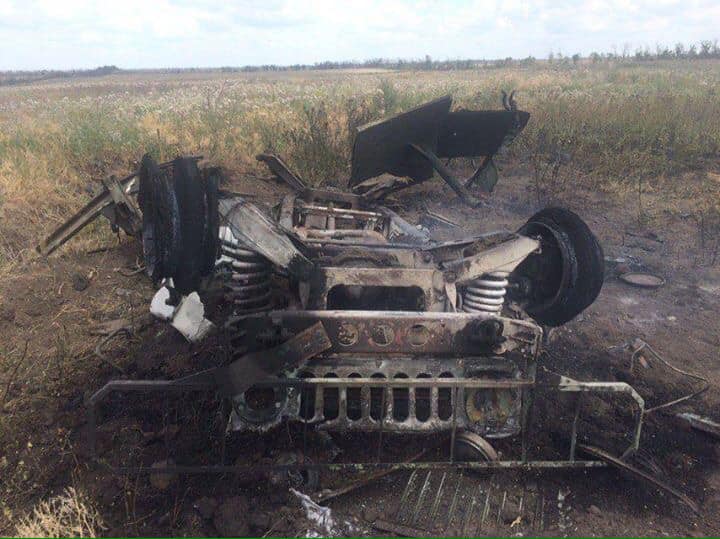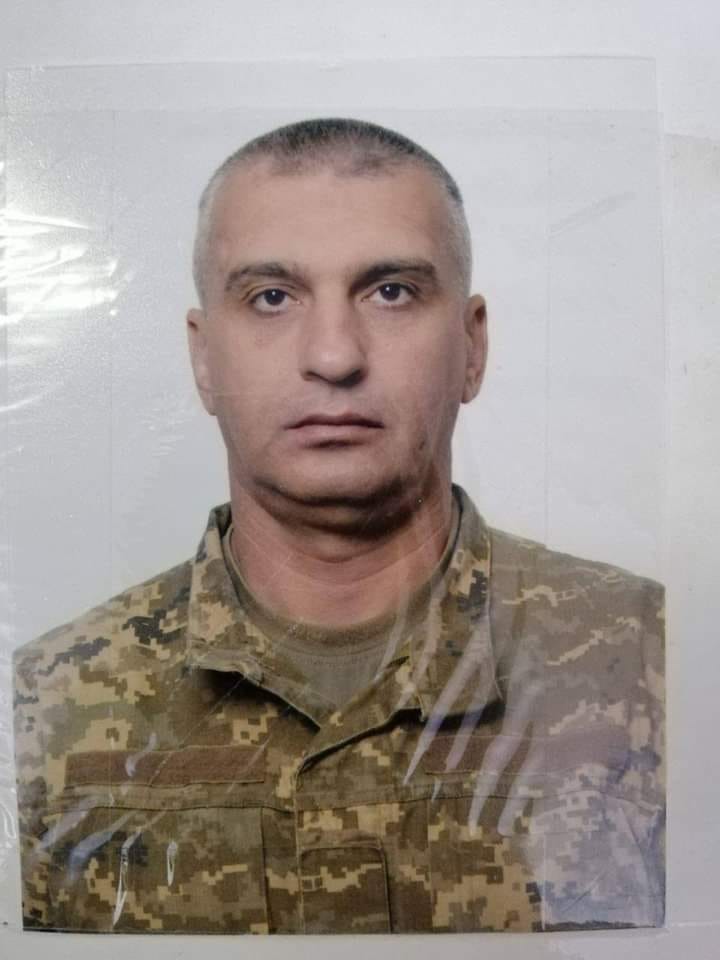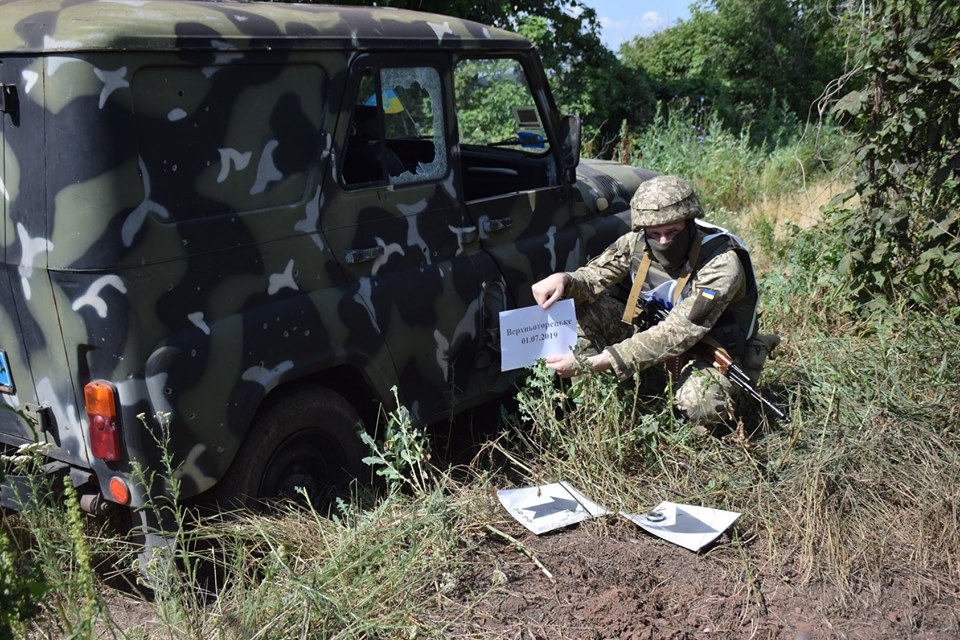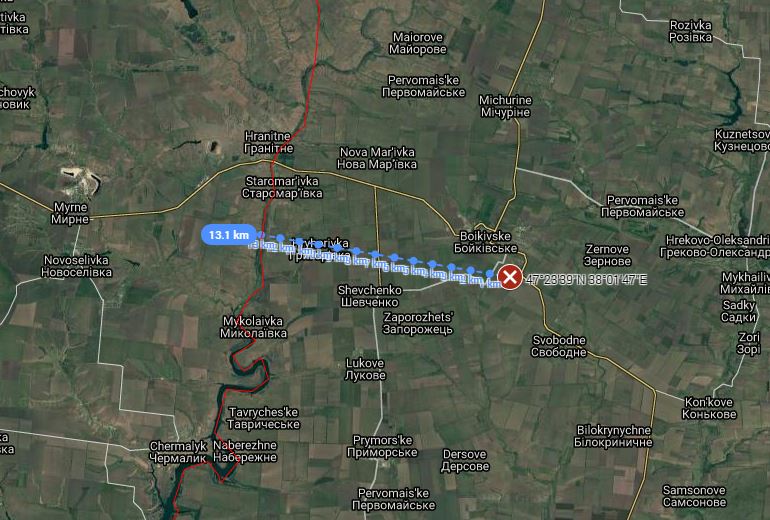On 28 June Ukrainian troops abandoned their advanced positions near the urban-type settlement of Stanytsia Luhanska north of the occupied regional capital city of Luhansk and retreated closer to the town to create a disengagement area agreed back in 2016. The military formations of the Russian-run so-called "Luhansk people's republic" ("LNR") have reportedly pulled out too. Can creating a new "gray zone" area endanger Stanytsia Luhanska?
"Today after we received guarantees from the OSCE Special Monitoring Mission to Ukraine (SMM) that the opposite side has pulled out its detachments outside the agreed area of the disengagement, we can finish the process of disengagement of our detachments and transfer our advanced detachment to another position."The Ukrainian troops reportedly retreated by 500 meters away from the line of the contact, and the "LNR people's militia's" detachments by 1500-1600 meters. The OSCE welcomed the disengagement. So did Ukrainian President Volodymyr Zelenskyy in his video address on 1 July and added,
"This is, I guess, the first step towards the steadfast ceasefire along the entire delimitation line, which occurred thanks to unblocking the Minsk process."
Read also: Are the new Minsk talks guiding Ukraine to capitulation?
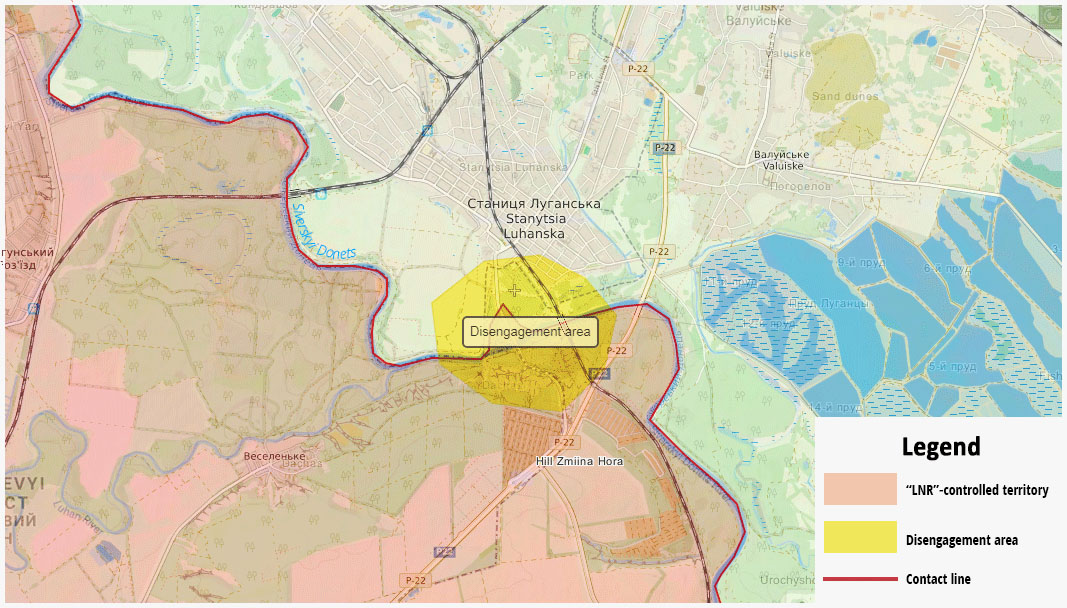
The decision on three disengagement zones - near Stanytsia Luhanska and Zolote in Luhansk Oblast, and near Petrivske south of Donetsk - was agreed in Minsk back in September 2016. Since then none was established since every time a disengagement was planned, hostilities escalated in the potential demilitarized area and the TCG postponed the issue for months later on.
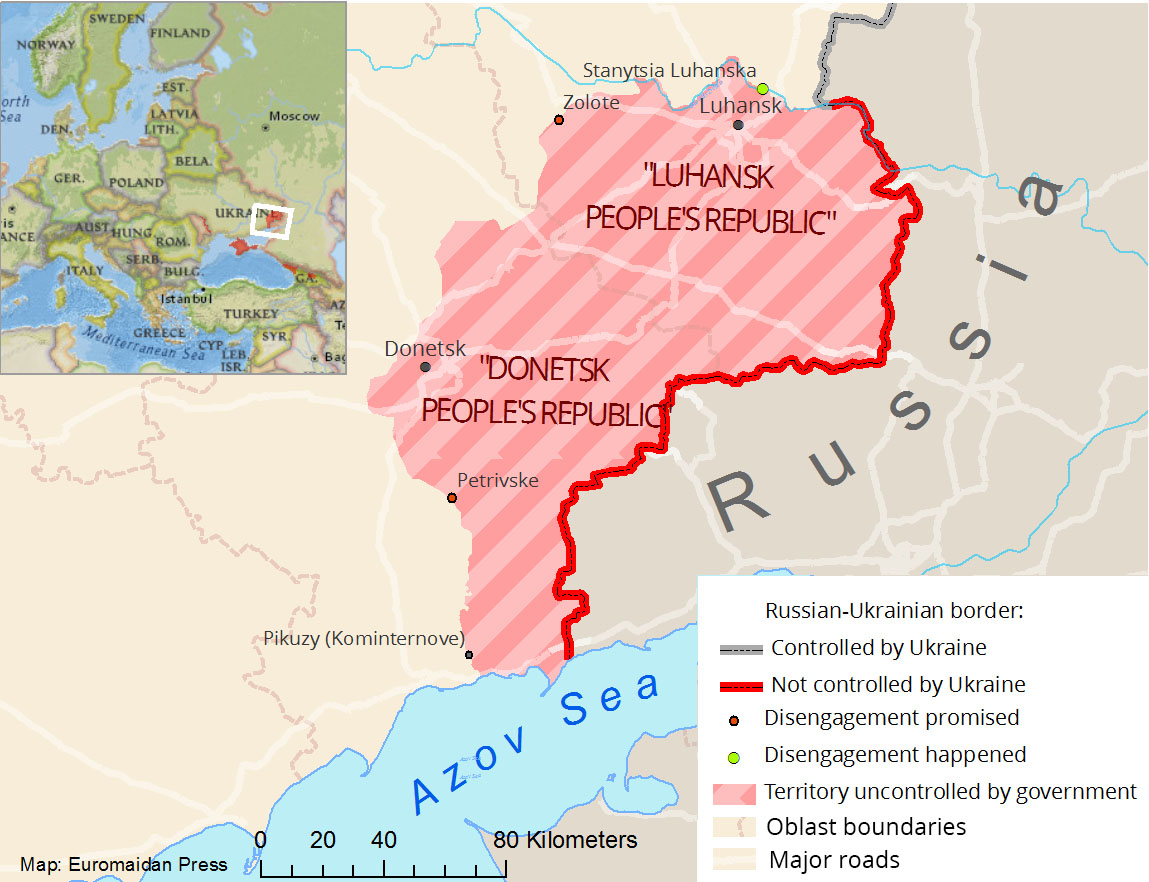 This disengagement in Stanytsia Luhanska is the first success since the demilitarized areas emerged in TCG plans. However, the very fact that Ukrainian troops have retreated for the first time since 2015 provoked public outrage in Ukrainian media. Moreover, the situation in other sections of the frontline is not that peaceful at all.
On the very same day before President Zelenskyy's video address came out on Twitter, the police reported that a police vehicle came under mortar fire in the front-line village of Verkhniotoretske north of Donetsk, two policemen got wounds. It also became known, that two civilian households came under fire in the town of Novoluhanske in the north of Donetsk Oblast, as well as the impacts damaged two homes in the city of Avdiivka in the same area. As well as residential housing sustained damage in some frontline areas of occupied Donetsk and Horlivka.
Overall on 30 June, the Armed Forces of Ukraine (AFU) recorded 23 fire attacks, 12 of which involved using heavy guns prescribed by the Minsk agreements.
https://twitter.com/JulianRoepcke/status/1145676783360053251
Several hours after Zelenskyy welcomed the disengagement near Stanytsia Luhanska, Russian hybrid forces hit a Ukrainian medevac HMMWV by an anti-tank guided missile, killing the driver and wounding two more servicepersons - marine Serhiy Maiboroda died on the spot, military doctor Iryna Shevchenko died later in hospital.
On 1 July, the number of attacks on Ukrainian forces in the Donbas totaled to 25. The 1 July Ukrainian casualties mounted to two killed in action and two more wounded. One more Ukrainian soldier got wounds on 2 July as the AFU recorded 13 attacks, and five more servicemen were wounded in 29 attacks on 3 July.
This disengagement in Stanytsia Luhanska is the first success since the demilitarized areas emerged in TCG plans. However, the very fact that Ukrainian troops have retreated for the first time since 2015 provoked public outrage in Ukrainian media. Moreover, the situation in other sections of the frontline is not that peaceful at all.
On the very same day before President Zelenskyy's video address came out on Twitter, the police reported that a police vehicle came under mortar fire in the front-line village of Verkhniotoretske north of Donetsk, two policemen got wounds. It also became known, that two civilian households came under fire in the town of Novoluhanske in the north of Donetsk Oblast, as well as the impacts damaged two homes in the city of Avdiivka in the same area. As well as residential housing sustained damage in some frontline areas of occupied Donetsk and Horlivka.
Overall on 30 June, the Armed Forces of Ukraine (AFU) recorded 23 fire attacks, 12 of which involved using heavy guns prescribed by the Minsk agreements.
https://twitter.com/JulianRoepcke/status/1145676783360053251
Several hours after Zelenskyy welcomed the disengagement near Stanytsia Luhanska, Russian hybrid forces hit a Ukrainian medevac HMMWV by an anti-tank guided missile, killing the driver and wounding two more servicepersons - marine Serhiy Maiboroda died on the spot, military doctor Iryna Shevchenko died later in hospital.
On 1 July, the number of attacks on Ukrainian forces in the Donbas totaled to 25. The 1 July Ukrainian casualties mounted to two killed in action and two more wounded. One more Ukrainian soldier got wounds on 2 July as the AFU recorded 13 attacks, and five more servicemen were wounded in 29 attacks on 3 July.
The latest events in the front-lines show that the disengagement near Stanytsia Luhanska is anything but a Russian attempt to achieve the steadfast ceasefire in the Donbas. Nothing has really changed in the rest of the front, moreover, the latest Minsk meeting didn't bring any results - neither the prisoner exchange nor another ceasefire was agreed.
Zolote entry-exit checkpoint
Back in 2016, Ukraine had prepared infrastructure at the checkpoint in the town of Zolote, where another disengagement area was agreed in Minsk, to be able to perform the inspection of pedestrians and vehicles. The Trilateral Contact Group (TCG, a.k.a. the Minsk Group) negotiated on the opening of the checkpoint for citizens at least four times and Ukraine tried did open its checkpoint in Zolote. The most recent attempt to open the control post was made on 24 March 2019. But the "LNR" didn't ever allow passage from the territory they control. The area of Zolote is one of Luhansk Oblast's hottest spots of the simmering conflict, and every time the checkpoint was about to be opened, the military activity suddenly escalated in the area. The pedestrian checkpoint in Stanytsia Luhanska remains the only place where citizens can cross the line of the contact. Anyone who wants to get info or from free Ukraine on a car should route via Donetsk Oblast, passing on the way "customs control" in Debaltseve on the "border between the LNR and the DNR" and making a few-hundred-kilometer way round back to Luhansk Oblast. No matter how far the troops disengaged near Stanytsia Luhanska, people should cover a distance of about 1.5km between the checkpoints on foot. The disengagement is intended to keep peace in the area and make it possible to renovate the wooden ramp at the blown up section of the bridge over Siverskyi Donets River or even the entire concrete span. Meanwhile, the checkpoint in Zolote could immediately enable direct bus service between the occupied and free parts of Luhansk Oblast.Pikuzy case
On 10 February 2015, Ukrainian troops retook the settlement of Kominternove in Donetsk Oblast. As the second Minsk agreement was signed a day later, the village found itself in the so-called "gray zone" after Ukraine withdrew its forces from the area. On 9 March 2015, the SMM facilitated the demining of Kominternove by the Ukrainian Armed Forces. The SMM's spot report noticed,Kominternove is located in between territory controlled by the government and areas controlled by “Donetsk People’s Republic” (“DNR”) and as a result has been subject to constant shelling since the beginning of the conflict. Since November 2014, the SMM has been working to facilitate dialogue amongst local commanders of the Ukrainian Armed Forces, “DNR” and Ukrainian and Russian Armed Forces staff of the Joint Centre for Control and Co-ordination (JCCC), as well as local residents. Finally on 3 March, all parties met – facilitated by the SMM – and agreed the terms, exact locations, composition of the demining team and date for demining Kominternove.Later that year, on 22 December, the Russian hybrid troops captured Kominternove without any fighting. Obeying the Minsk Agreements, Ukraine didn't take any action to liberate the village. This video from 15 January 2016 shows the armed "DNR" militants securing the OSCE SMM patrol, as well as the microphones of the Russian TV channels - First Channel, NTV, Channel 5, Life News, Zvezda, Rossiya:
“One of the basic aims of Minsk is to create a Security Zone – a zone that is ‘without danger.’ Children, women and men in Kominternove rely on forces on both sides to make this a reality. However I hardly need to spell it out: this zone is still full of danger,” the Principal Deputy Chief Monitor Alexander Hug told the Russian media in Kominternove.Later on, Kominternove and its vicinity became a "DNR" stronghold which has often been used to harass the nearby Ukraine-controlled villages of Hnutove, Talakivka, and Vodiane, which all are often mentioned in the daily communiqués of the Ukrainian Army. For now, Pikuzy - this is how Kominternove was renamed in absentia under the Ukrainian de-communization law in 2016 - remains occupied and the positions near it are among the most active in the Mariupol area of Donetsk Oblast.
Can Ukraine lose Stanytsia Luhanska now?
The higher uncontrolled bank of Donets near Stanytsia Luhanska is a natural dominating high ground in the area stretched for many kilometers. However, Donets itself is a natural obstacle to a sudden attack on the settlement. Meanwhile, Zolote is located on the higher slope of the arroyo of a small stream called Komyshuvakha River. The Ukrainian control of the high ground can be the reason why the Russian hybrid forces oppose opening the civil checkpoint in Zolote.
Ukrainian troops didn't leave Stanytsia Luhanska, they have retreated closer to the town away from Siverskyi Donets River. Thus, there is no immediate threat to the settlement for now. However, the Russian hybrid forces can profit by the occasion and covertly gain a foothold in the forest areas between Stanytsia Luhanska and Siverskyi Donets abandoned by the Ukrainian troops.
"The last time I slept on the second floor was during the night of 11/12 February, after the Minsk-2 ceasefire agreement was finally signed by the leaders of Ukraine, Russia, Germany, and France. The following day was comparatively calm – maybe a dozen bombardments in total, rather than up to a hundred per day, as before. That night the enemy fired at us once... As for me, I realized that the short periods of “ceasefire” after Minsk-2 simply indicated times when the enemy needed to resupply or re-target his artillery and MLRSs… That very next night, at 3am, our camp received its worst bombardment – blasted by all kinds of heavy weaponry from three sides. Rockets and shells hit our building multiple times, demolishing many rooms on the second and first floors, including our custom-made, makeshift chapel room." Mr. Kovalenko wrote.Later in early 2015 when Ukrainian troops were forced to retreat from Debaltseve and Donetsk Airport, the situation mostly settled and multiple seasonal ceasefires have been agreed in Minsk since then. However, the fighting hasn't fully ceased until now. The troops entrenched from both sides of the contact line and continued fire attacks, seizing settlements in the gray zone, and conducting rare local offensive operations. In five years after the Minsk-2 was signed, the Ukrainian military reported only several days when no fire attacks took place.
Read also:
- Are the new Minsk talks guiding Ukraine to capitulation?
- Everything you wanted to know about the Minsk peace deal, but were afraid to ask
- War on terms: who’s fighting against Ukraine in Donbas – terrorists, rebels, insurgents?
- Is Russia’s passport scheme in Donbas a harbinger of full-scale invasion like in 2008 Georgia?
- Ukraine’s economic losses due to Russian occupation of Donbas
- Human rights NGO reports on 119 known hostages behind bars in occupied Donbas
- OSCE drone films Russian trucks entering Donbas at night
- Putin seized Crimea with regular army but outsourced action in Donbas

